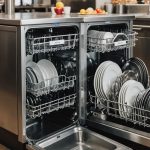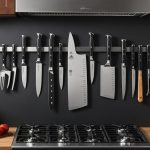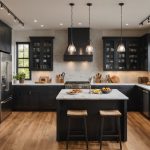Creating a wheelchair-friendly bar space requires thoughtful design and genuine inclusivity. Consider accessible entrances, spacious layouts, and friendly staff training as vital elements. Attention to detail, such as adaptive seating and accessible restrooms, significantly enhances the experience for all patrons. This commitment not only invites diverse clientele but fosters a welcoming atmosphere, allowing everyone to enjoy social interactions without barriers. Embrace these essentials to not only meet legal standards but also to enrich your community.
Importance of Inclusivity in Bar Design
Creating welcoming spaces for all patrons.
Additional reading : Essential Dishwasher Features for Water Conservation in High-Volume Restaurants
Benefits of Creating an Inclusive Environment
Incorporating inclusivity in bar design enhances customer satisfaction and broadens the clientele base. An inclusive bar environment fosters a sense of belonging and comfort, encouraging repeat visits. This approach not only benefits patrons but also boosts business profitability.
Impact of Accessibility on Customer Experience
Accessibility is a cornerstone of inclusivity, directly affecting the customer experience. Bars that prioritize accessibility ensure that all patrons, regardless of physical abilities, can enjoy their time without barriers. This commitment to inclusivity can significantly enhance the reputation of an establishment and create positive word-of-mouth marketing.
This might interest you : Key Features of an Ideal POS System for Restaurants Offering Dine-In and Drive-Through Services
Legal Requirements for Accessibility in Public Spaces
Compliance with legal requirements is essential for any public space, including bars. These regulations mandate that venues accommodate people with disabilities, ensuring equal access. Failure to meet these standards can result in legal consequences and damage to the business's reputation.
Key Accessibility Features:
- Wheelchair ramps
- Accessible restrooms
- Clear signage
By integrating these features, bars not only comply with the law but also demonstrate a commitment to creating an inclusive environment. Emphasizing inclusivity in bar design is not just a legal obligation; it's a strategic advantage that enriches the customer experience.
Key Design Elements for Wheelchair Accessibility
Creating spaces that prioritize mobility and comfort.
Importance of Space Layout for Mobility
Effective wheelchair accessibility design begins with thoughtful space layout. Ensuring ample room for mobility is crucial. This involves strategic placement of furniture and fixtures to avoid obstacles. A well-planned layout enhances the ease with which patrons can navigate the space, ensuring a seamless experience for all.
Recommended Aisle Widths and Circulation Space
Aisle widths and circulation space are vital components of wheelchair accessibility design. For optimal mobility, aisles should be at least 36 inches wide. This width accommodates most wheelchairs, allowing for smooth passage. Additionally, ensuring adequate turning space, typically 60 inches in diameter, is essential for comfort and accessibility.
Considerations for Bar Height and Seating Arrangements
Bar height and seating arrangements play a significant role in wheelchair accessibility design. Standard bar height should be around 34 inches to accommodate wheelchair users. Providing a mix of seating options, such as adjustable-height stools and tables, ensures inclusivity.
Key Design Elements:
- Minimum aisle width of 36 inches
- Turning space of 60 inches diameter
- Bar height of 34 inches
By implementing these design elements, bars can create an environment that is not only welcoming but also functional and accessible for everyone.
Furniture Selection for Wheelchair Users
Creating adaptable and comfortable seating solutions.
Types of Chairs and Tables Suitable for Accessibility
Selecting the right wheelchair-friendly furniture is vital for creating an inclusive environment. Opt for chairs without armrests and with appropriate seat height to accommodate wheelchair users comfortably. Tables should have a clearance of at least 27 inches underneath to allow wheelchairs to fit easily. Prioritizing these features ensures that all patrons can enjoy their experience without discomfort.
Durability and Maintenance of Wheelchair-Friendly Furniture
Wheelchair-friendly furniture should be durable and easy to maintain. Materials like metal or reinforced wood are ideal for their strength and longevity. Regular maintenance checks can prevent wear and tear, ensuring the furniture remains safe and functional for all users. This proactive approach extends the lifespan of the furniture and maintains a welcoming atmosphere.
Strategies for Flexible Seating Arrangements
Flexibility in seating arrangements enhances the accessibility of a space. By incorporating movable tables and chairs, establishments can adapt to the varying needs of their patrons. This adaptability allows for easy reconfiguration of the layout to accommodate larger groups or individual wheelchair users.
Key Considerations:
- Chairs without armrests
- Tables with 27-inch clearance
- Movable seating options
Incorporating these strategies ensures that wheelchair-friendly furniture not only meets accessibility standards but also enhances the overall customer experience.
Accessibility Features in Bar Design
Enhancing customer experience through thoughtful design.
Ramps and Entrances
Ramps and entrances are fundamental bar accessibility features. They provide seamless access for wheelchair users and those with mobility challenges. Ensuring ramps have a gentle slope and non-slip surfaces is crucial for safety. Entrances should be wide enough to accommodate wheelchairs and equipped with automatic doors or easy-to-use handles.
Key Considerations:
- Gentle slope ramps
- Non-slip surfaces
- Automatic doors
Accessible Restrooms
Accessible restrooms are essential in any inclusive bar design. They must comply with ADA guidelines, featuring grab bars, adequate turning space, and accessible sinks. Ensuring these bar accessibility features are present enhances comfort and independence for all patrons.
Signage and Wayfinding
Clear signage and wayfinding are critical bar accessibility features that aid navigation. Signs should be at an appropriate height, with large, legible fonts. Incorporating visual cues like arrows or color coding can significantly improve the ease of finding essential areas, such as restrooms or exits.
Key Features:
- Legible fonts
- Visual cues
- Strategic placement
By integrating these bar accessibility features, establishments not only comply with legal standards but also create a welcoming environment for everyone.
Staff Training for Inclusivity
Enhancing customer interactions through knowledgeable staff.
Importance of Training for Staff on Accessibility Awareness
Staff training in inclusivity is crucial for creating a welcoming environment. Training programs should cover accessibility awareness, ensuring that employees understand the diverse needs of patrons, especially those using wheelchairs. This knowledge empowers staff to provide better service, fostering an atmosphere of respect and understanding.
Strategies for Effective Communication with Wheelchair Users
Effective communication is a cornerstone of staff training for inclusivity. Staff should be trained to engage with wheelchair users at eye level, using clear and respectful language. Encouraging the use of open-ended questions can help understand individual needs. These strategies ensure interactions are positive and inclusive.
Key Communication Strategies:
- Maintain eye contact at eye level
- Use clear, respectful language
- Employ open-ended questions
Creating a Welcoming Environment Through Staff Attitudes
The attitude of staff plays a significant role in promoting inclusivity. Training should emphasize the importance of a positive and proactive approach. Staff should be encouraged to anticipate needs and offer assistance without being intrusive. A welcoming environment is cultivated through genuine hospitality and attentiveness, making all patrons feel valued.
By focusing on staff training in inclusivity, bars can enhance customer satisfaction and build a reputation for being accessible and welcoming to everyone.
Case Studies of Successful Wheelchair-Friendly Bars
Exploring real-world applications of inclusive bar design.
Examples of Inclusive Bar Designs
Several inclusive bar case studies highlight successful implementations of wheelchair-friendly features. For instance, The Green Door in Boston redesigned its layout to include wider aisles and accessible seating. Another example is The Blue Oyster in New York, which integrated adjustable-height tables and ramps with gentle slopes.
Lessons Learned from Successful Implementations
These inclusive bar case studies provide valuable insights. A key lesson is the importance of involving wheelchair users in the design process to ensure practical solutions. Establishments like The Red Lantern found that staff training on accessibility awareness significantly enhanced customer satisfaction.
Key Takeaways:
- Involve wheelchair users in design
- Prioritize staff training
- Implement flexible seating options
Community Feedback on Inclusive Bars
Feedback from the community in these inclusive bar case studies has been overwhelmingly positive. Patrons appreciate the thoughtful design and report feeling more welcome. One customer from The Green Door stated, "It's refreshing to visit a place where I don't have to worry about accessibility." Such feedback underscores the impact of inclusive design on customer loyalty and business success.
By examining these inclusive bar case studies, other establishments can learn and apply these strategies to create welcoming environments for all patrons.
Legal Guidelines and Compliance for Accessibility
Ensuring adherence to essential standards.
Overview of the ADA and Its Implications for Bars
The Americans with Disabilities Act (ADA) sets forth critical accessibility legal requirements for public spaces, including bars. This legislation mandates that establishments provide equal access to individuals with disabilities, influencing everything from entryways to restroom facilities. Bars must incorporate features like ramps and accessible seating to comply with ADA standards, thus fostering an inclusive environment.
Local Regulations That May Impact Design
Beyond federal mandates, local regulations can also affect accessibility legal requirements. These rules may vary by region, requiring establishments to stay informed about specific design criteria. For example, some localities may have stricter guidelines on aisle widths or signage placement. Understanding these nuances ensures bars meet all necessary legal obligations.
Resources for Staying Compliant with Accessibility Laws
Staying compliant with accessibility legal requirements can be complex, but various resources are available to assist. Consulting with architects specializing in accessibility and engaging with local disability advocacy groups can provide valuable insights. Additionally, regularly reviewing updates from governmental bodies helps ensure ongoing compliance.
Key Resources:
- Accessibility consultants
- Local advocacy groups
- Governmental updates
By leveraging these resources, bars can navigate the complexities of compliance, ensuring they meet both federal and local accessibility legal requirements effectively.
Future Trends in Inclusive Bar Design
Exploring the evolving landscape of accessibility in the hospitality industry.
Innovations in Accessible Design Technology
The future of inclusive design in bars is being shaped by cutting-edge technologies. Innovations such as smart lighting and automated door systems enhance accessibility, allowing patrons to navigate spaces with ease. Voice-activated controls are becoming popular, enabling hands-free interaction with various elements within the bar environment. These advancements not only improve functionality but also elevate the overall patron experience.
The Role of Community Input in Future Bar Developments
Community input is increasingly vital in the future of inclusive design. Engaging with local disability advocacy groups provides valuable insights into the needs and preferences of wheelchair users. This collaboration ensures that new bar designs are not only compliant but also genuinely welcoming. By prioritizing community feedback, bars can create spaces that reflect the diverse needs of their clientele.
Predictions for Accessibility Trends in the Hospitality Industry
The hospitality industry is poised to embrace several accessibility trends. There is a growing emphasis on universal design principles, which aim to make environments usable by all people, regardless of age or ability. Additionally, the integration of sustainable materials in accessible features is gaining traction, aligning with broader environmental goals.
Key Predictions:
- Increased use of smart technologies
- Greater community collaboration
- Emphasis on universal and sustainable design
By focusing on these trends, the hospitality industry can lead the way in creating inclusive and innovative bar environments.











